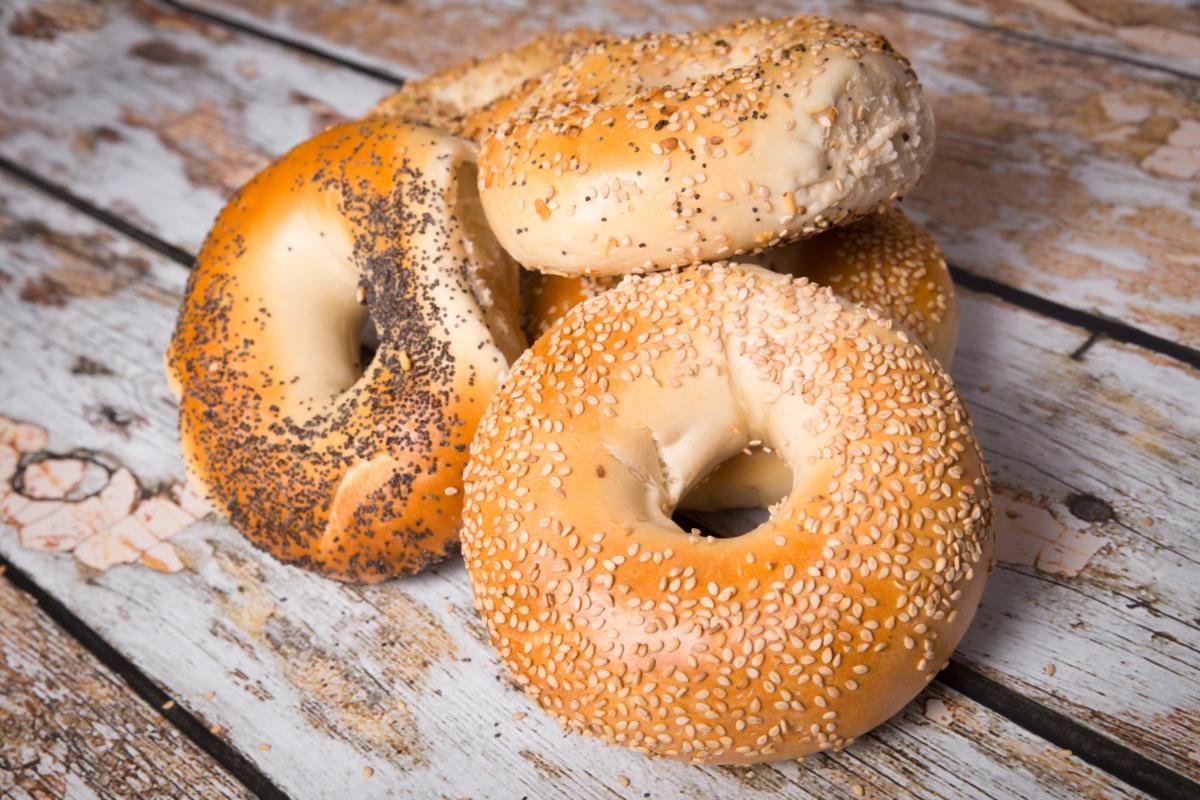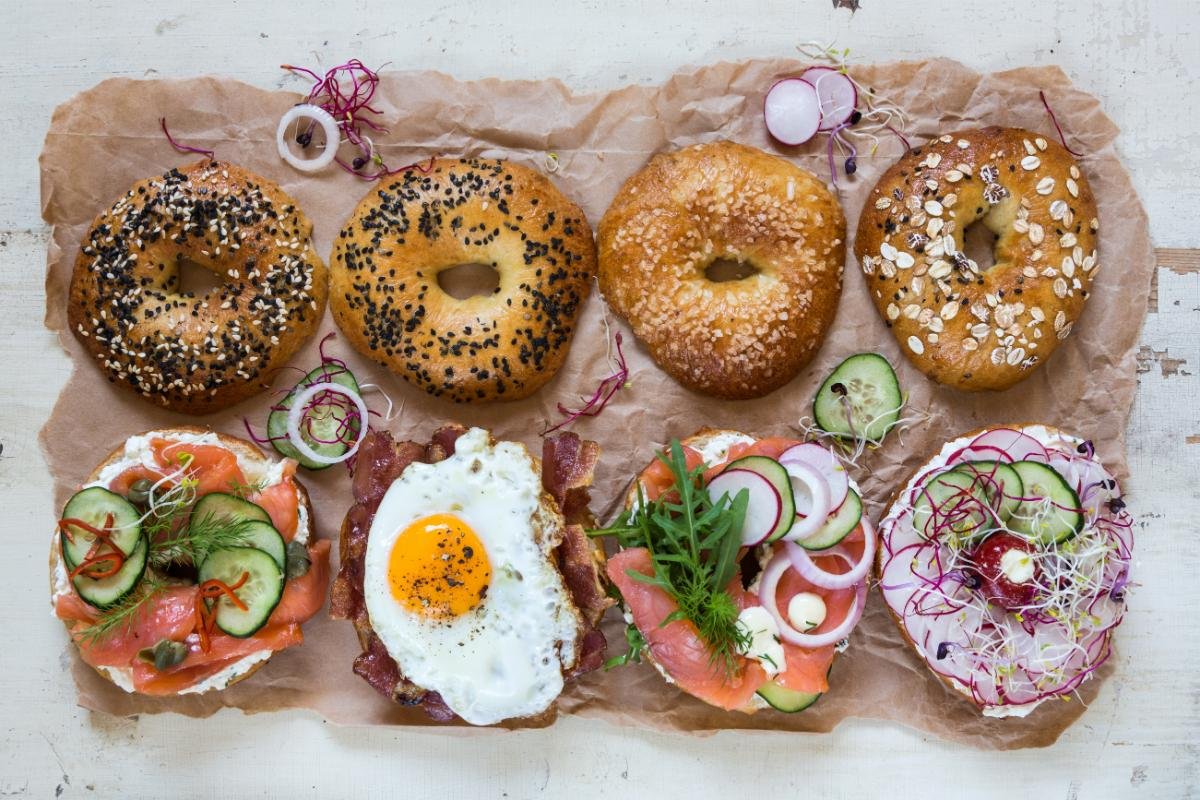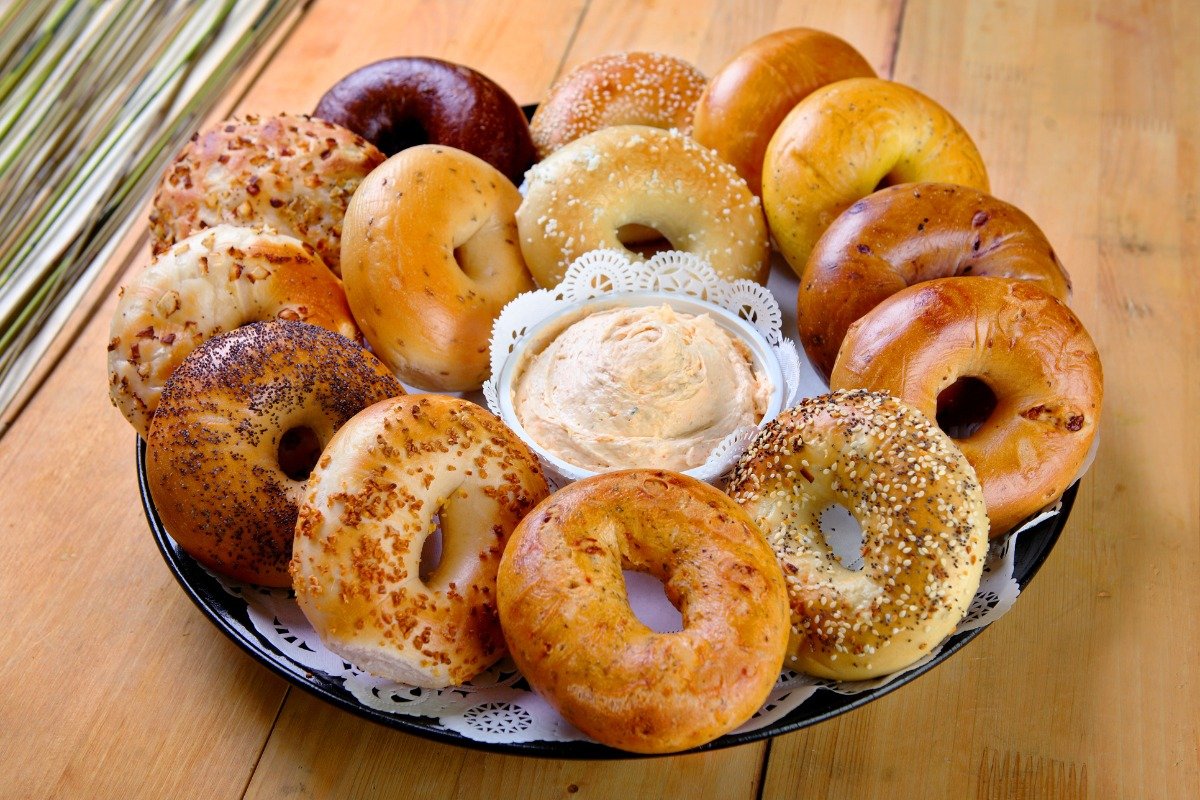The popularity of gluten-free diets has surged in recent years, not just among those with celiac disease but also with individuals looking to improve their health and wellbeing. This dietary shift has prompted bakeries and food producers to innovate, creating delicious and satisfying alternatives to gluten-containing staples. Among these, the bagel, a beloved breakfast and brunch staple, has seen an exciting transformation. Gluten-free bagels are now available, offering the same delightful experience without the gluten. This blog explores the world of gluten-free bagels, from the science behind gluten to homemade recipes and where to find the best gluten-free bagels.
What is Gluten?
Gluten is a protein composite found in wheat, barley, rye, and triticale. It acts as a glue that holds food together, giving elasticity and shape to dough, which is crucial for the texture of baked goods. When mixed with water, gluten proteins form a sticky network that can trap air bubbles, allowing breads and bagels to rise and maintain their structure. This elasticity and chewiness are particularly prized in traditional bagel making.
For individuals with celiac disease, consuming gluten triggers an immune response that damages the small intestine, leading to malabsorption of nutrients and various health issues ranging from gastrointestinal symptoms to neurological problems. Gluten sensitivity, though not as severe as celiac disease, causes similar symptoms without the intestinal damage. As such, avoiding gluten is not a dietary choice but a necessity for these individuals.
Additionally, some people opt for a gluten-free diet to alleviate other health issues or as a lifestyle choice, believing it to lead to overall health improvements and weight management. This dietary shift has pushed the food industry to innovate, creating gluten-free versions of many traditional foods, including bagels, without compromising on taste and texture.
Understanding gluten’s role in traditional baking emphasizes the challenge gluten-free baking faces. The quest for the perfect gluten-free bagel is not just about substituting flours but also replicating the unique properties that gluten imparts to baked goods.
The Journey to the Perfect Gluten-Free Bagel

Embarking on the quest for the perfect gluten-free bagel means delving into the heart of traditional bagel baking, understanding the role of gluten, and then innovating to recreate that distinct bagel experience without it. This journey involves both the evolution of gluten-free baking techniques and the careful selection of alternative ingredients.
Rediscovering Bagel Tradition Without Gluten
Traditional bagel making is an art form, involving a high-gluten flour dough that is boiled then baked to achieve that characteristic glossy crust and chewy interior. The challenge in gluten-free bagel making is to replicate this texture and taste without the structural benefits of gluten. This endeavor has led bakers and food scientists to explore a variety of non-traditional flours and ingredients, reimagining the bagel-making process.
Innovating Gluten-Free Baking Techniques
Gluten-free baking is not simply a matter of substituting wheat flour with gluten-free flour. It requires a rethinking of the entire baking process, from dough preparation to baking techniques. Innovations in this field include:
- Hydration Ratios: Gluten-free flours absorb liquids differently, necessitating adjustments in hydration to achieve the right dough consistency.
- Binders and Leaveners: Ingredients like xanthan gum, guar gum, and eggs are introduced as binders to mimic gluten’s elasticity. Meanwhile, adjustments in yeast amounts and proofing times help ensure the dough rises adequately.
- Baking Conditions: Gluten-free bagels often benefit from slightly altered baking temperatures and steam conditions to enhance crust development and interior texture.
Pioneering Ingredients for Texture and Taste
The search for the right blend of gluten-free flours is at the core of developing a good gluten-free bagel. This blend often includes:
- Rice Flour: Offers a neutral taste and helps in achieving a desirable crumb.
- Tapioca and Potato Starch: Work to lighten the texture, making it less dense.
- Almond and Coconut Flour: Provide moisture, richness, and a slight nutty flavor, enhancing the overall taste profile.
In addition to these flours, ingredients like apple cider vinegar or a touch of honey are used to improve taste and texture, adding subtle flavors and aiding in browning.
Ingredients for Gluten-Free Bagels
Crafting the perfect gluten-free bagel requires a careful selection of alternative flours and other ingredients. These components must work in harmony to mimic the texture and flavor of traditional bagels, while adhering to gluten-free dietary restrictions. Let’s explore the key ingredients that make this possible.
Flour Alternatives: The Foundation
Gluten-free bagel recipes begin with the right blend of flours. No single gluten-free flour can replicate wheat flour’s properties, making blends essential.
- Rice Flour: Often the base of gluten-free flour blends, rice flour provides a neutral flavor and helps form the structure of the bagel.
- Tapioca Flour: Adds chewiness and helps in browning. It’s a crucial component for achieving a bagel’s classic texture.
- Almond Flour: Brings richness and a slight nuttiness, contributing to a more complex flavor profile. It also adds moisture, combating the dryness often associated with gluten-free baked goods.
- Coconut Flour: Highly absorbent, it’s used sparingly to prevent dryness but contributes fiber and a subtle sweetness.
- Cornstarch: Lightens the dough, improving the texture of the bagel’s crumb.
Binders: Simulating Gluten’s Elasticity
Without gluten, other ingredients must be used to provide the dough’s elasticity and structure.
- Xanthan Gum: A common gluten substitute that adds viscosity and elasticity to the dough, helping it to rise and maintain shape.
- Guar Gum: Similar to xanthan gum, it can be used as an alternative or in conjunction to improve texture.
- Psyllium Husk: Adds fiber and helps bind moisture, which is especially important for achieving a chewy bagel texture.
Moisture and Flavor Enhancers
The right balance of wet ingredients and flavor enhancers is critical in gluten-free bagel recipes, ensuring the bagels are not only tasty but also have the correct texture.
- Eggs: Provide structure and moisture, crucial for holding the bagel together and aiding in leavening.
- Apple Cider Vinegar: A small amount can improve the rise of the dough and enhance the flavor of the bagel.
- Honey or Maple Syrup: These natural sweeteners can enrich the dough’s flavor, feed the yeast for a better rise, and contribute to browning.
Leavening Agents: Achieving the Perfect Rise
The rise of gluten-free bagels relies on the careful use of leavening agents, compensating for the lack of gluten.
- Yeast: Active dry or instant yeast is essential for that traditional bagel flavor and texture, helping the dough to rise and develop its structure.
- Baking Powder: Sometimes used in conjunction with yeast to help lift the dough and improve texture.
Making Gluten-Free Bagels at Home

Creating gluten-free bagels in your own kitchen is a rewarding endeavor. With the right ingredients and techniques, you can bake bagels that rival those found in specialty bakeries. This section provides a comprehensive, step-by-step guide to making gluten-free bagels, ensuring success even for those new to gluten-free baking.
Preparing Your Ingredients and Tools
First, gather all necessary ingredients based on the list provided in the previous section. Ensure you have a reliable gluten-free flour blend, xanthan gum (if not included in your flour blend), baking powder, yeast, sugar, warm water, an egg, apple cider vinegar, and any preferred mix-ins like sesame seeds or poppy seeds for topping.
You’ll also need a few key tools: mixing bowls, a dough whisk or a stand mixer with a dough hook attachment, a baking sheet, parchment paper, a large pot for boiling the bagels, a slotted spoon, and a cooling rack.
Mixing the Dough
- Activate the Yeast: Dissolve a teaspoon of sugar in warm water (about 110°F or 45°C), then sprinkle the yeast over the top. Let it sit for 5-10 minutes until frothy, indicating that the yeast is active.
- Combine Dry Ingredients: In a large mixing bowl, whisk together your gluten-free flour blend, xanthan gum (if using), and baking powder.
- Form the Dough: To the yeast mixture, add the egg and apple cider vinegar, mixing well. Pour the wet ingredients into the dry, combining until a dough forms. If the dough seems too sticky, add a bit more flour; if too dry, add water, a tablespoon at a time.
Shaping and Boiling the Bagels
- Shape the Bagels: Divide the dough into equal portions, rolling each into a ball. Press a finger through the center of each ball to form a hole, and gently stretch the dough to shape the bagel. Place the shaped bagels on a parchment-lined baking sheet.
- Boil the Bagels: Bring a large pot of water to a boil and add a tablespoon of sugar (this helps with browning and texture). Boil each bagel for about 30 seconds on each side, then remove with a slotted spoon and place back on the baking sheet.
Baking to Perfection
- Preheat the Oven: While the bagels are boiling, preheat your oven to 425°F (220°C).
- Add Toppings: Brush the top of each boiled bagel with a beaten egg (egg wash) and sprinkle with your choice of toppings.
- Bake: Bake in the preheated oven for 20-25 minutes or until the bagels are golden brown and sound hollow when tapped on the bottom.
- Cool: Transfer the baked bagels to a cooling rack and let them cool completely before slicing.
Where to Find Gluten-Free Bagels
While making gluten-free bagels at home is a rewarding experience, sometimes convenience or curiosity leads us to seek them elsewhere. Fortunately, the availability of gluten-free bagels has expanded significantly, with many bakeries, grocery stores, and online retailers offering delicious options. This section will guide you on where to find gluten-free bagels and how to ensure they meet your dietary needs.
Specialty Bakeries and Cafes
Many specialty bakeries and cafes now cater to gluten-free diets, often offering bagels among their selections. These establishments usually take cross-contamination seriously, making them safe options for those with celiac disease or severe gluten sensitivities.
- Research Local Options: Use online reviews and gluten-free community forums to find recommended bakeries in your area.
- Ask Questions: Don’t hesitate to inquire about their gluten-free practices, including separate preparation areas and utensils.
Grocery Stores and Supermarkets
The gluten-free section in grocery stores and supermarkets has grown, with many brands now offering pre-packaged gluten-free bagels.
- Read Labels Carefully: Look for certifications from gluten-free organizations, which indicate that the product meets strict gluten-free standards.
- Check Ingredients: Even if a product is labeled gluten-free, review the ingredients list for any allergens or additives you may wish to avoid.
Online Retailers
Online shopping provides access to a wide variety of gluten-free bagel brands, including some that may not be available locally.
- Explore Gluten-Free Marketplaces: Websites dedicated to gluten-free products often carry a selection of bagels from various brands, allowing you to try different types.
- Consider Subscription Services: Some services deliver gluten-free baked goods, including bagels, directly to your door, offering convenience and variety.
Tips for Selecting Gluten-Free Bagels
When choosing gluten-free bagels, consider the following tips to ensure satisfaction and safety:
- Flavor and Texture Preferences: Experiment with different brands and recipes to find bagels that best match your taste and texture preferences.
- Nutritional Content: Gluten-free doesn’t automatically mean healthier, so check the nutritional information to make informed choices, especially if you have specific dietary goals or restrictions.
FAQ
Can gluten-free bagels taste as good as traditional bagels?
Yes, gluten-free bagels can taste just as delicious as traditional bagels. With the right blend of gluten-free flours and ingredients, you can achieve a similar texture and flavor. The key is experimenting with different recipes and ingredients to find what works best for you.
What’s the best flour blend for gluten-free bagels?
The best flour blend for gluten-free bagels often includes a mix of rice flour, tapioca flour, almond flour, and sometimes potato or cornstarch. Each flour contributes to the texture and flavor of the bagel. Pre-made gluten-free all-purpose flour blends can also work well and simplify the process.
Are gluten-free bagels healthier than regular bagels?
Gluten-free bagels are not inherently healthier than regular bagels, as their nutritional value depends on the ingredients used. Gluten-free bagels can be a healthier option for individuals with celiac disease or gluten sensitivities, as they avoid the health issues associated with gluten consumption. Always check the nutritional content to make informed dietary choices.
How do I prevent my gluten-free bagels from becoming too dense?
To prevent gluten-free bagels from becoming too dense, ensure your dough is properly hydrated and doesn’t contain too much flour. Adding a little extra leavening agent, such as baking powder, can also help. Be careful not to overmix the dough, as this can make bagels dense.
Can I freeze gluten-free bagels?
Yes, gluten-free bagels freeze well. Allow them to cool completely after baking, then slice and wrap them individually or store them in a freezer-safe bag. To enjoy, simply thaw at room temperature or toast directly from the freezer.
Where can I find gluten-free bagel toppings?
Gluten-free bagel toppings can be found in most grocery stores. Common toppings include cream cheese, butter, jam, and peanut butter. For savory options, consider avocado, smoked salmon, or hummus. Always check labels to ensure toppings are gluten-free.
Conclusion
The journey through the world of gluten-free bagels reveals not just the culinary creativity required to bypass traditional ingredients but also the growing support for diverse dietary needs. Whether you’ve embarked on this gluten-free journey due to health reasons or personal choice, it’s clear that enjoying a delicious, chewy bagel without the gluten is more accessible than ever. From mastering the art of baking your own at home to discovering the best store-bought or bakery-fresh options, the quest for the perfect gluten-free bagel can be both a delicious endeavor and a path to greater dietary inclusivity.
For those inspired to continue exploring gluten-free recipes, including a variety of bagel flavors and toppings, be sure to visit RecipesZap.com. Our website is dedicated to providing you with an array of recipes that cater to gluten-free diets without compromising on taste or quality.
Additionally, for further reading and resources on gluten-free living, Celiac Disease Foundation offers extensive information, support, and guidance for managing a gluten-free diet, making it an invaluable resource for anyone navigating the gluten-free lifestyle.
In the end, whether you’re enjoying a gluten-free bagel that’s toasted to perfection and slathered with your favorite spread, or you’re rolling up your sleeves to bake a batch from scratch, the world of gluten-free bagels is rich with possibilities. Happy baking and eating!

